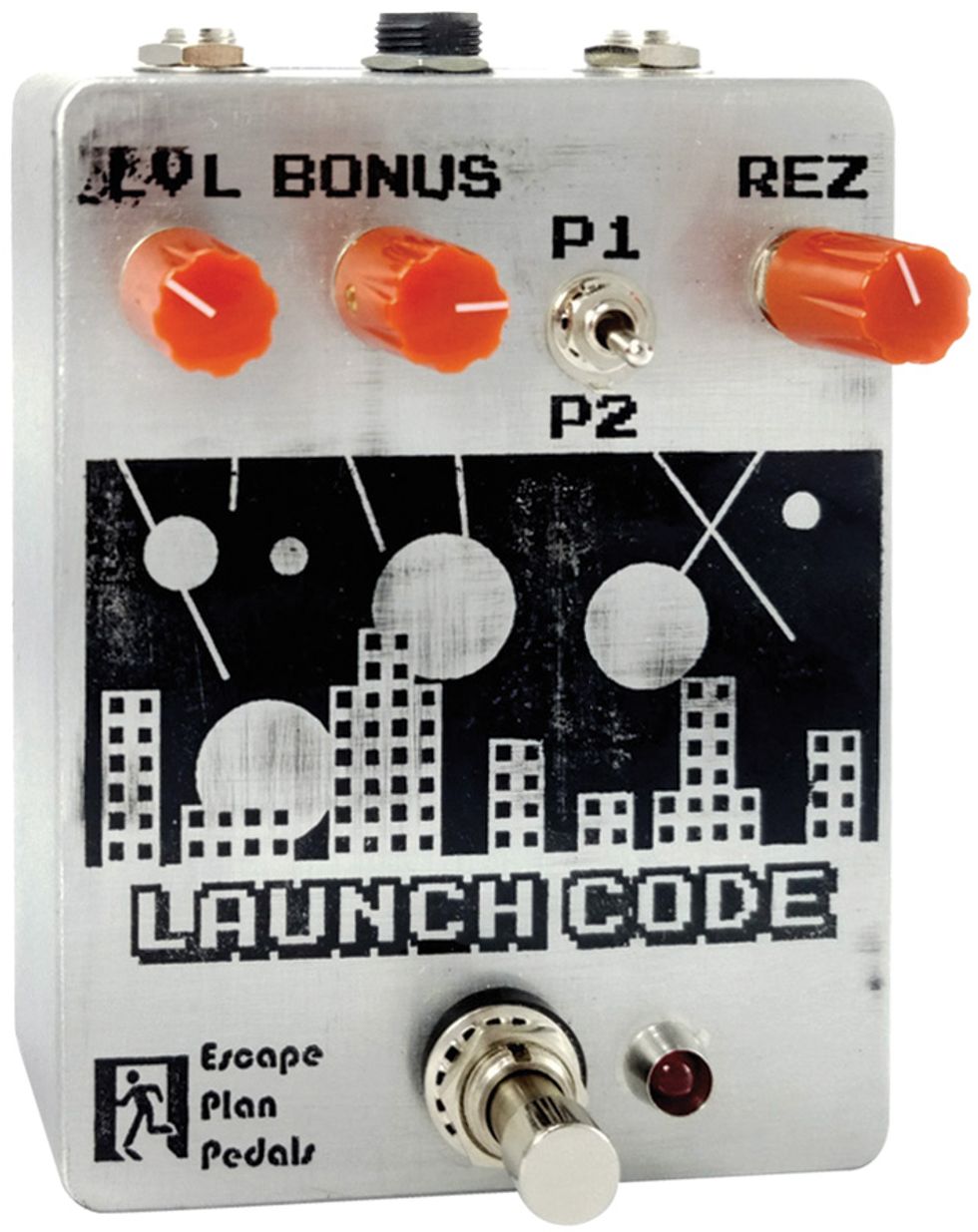RatingsPros:Delicious glitchiness that can range to real musicality. Fun control set. Cool octave tones. Cons: High-end notes can lack resonance. Street: $169 Escape Plan Launch Code escapeplanpedals.com | Tones: Ease of Use: Build/Design: Value: |
I loved the surreal chaos of old video games. But I think I dug the glitchy, globular, and crusty soundtracks that accompanied the chaos even more. Escape Plan Pedals’ Launch Code generates tones inspired by the sounds of old Atari and early Nintendo console games. And in the most wonderful way, it can also evoke the chaos of playing them. It’s exciting and unpredictable. It’s also surprisingly musical at times—evoking the sounds of old, weird octave machines like the Mu-Tron Octave Divider and MXR Blue Box (or at least the sounds of those pedals trapped inside a Missile Command machine).
Primed to “Pew Pew”
On a first outing with the Launch Code, it helps to think of the pedal as a little synth as much as a guitar stompbox. Escape Plan’s main brain Andy Greene clearly considered vintage analog synth design in conceiving the device, and it has that feel. Input signal is converted to a square wave at the front end of the pedal, which then passes through a series of oscillators. This simple but effective bit of the circuit does the lion’s share of signal mutation. But you can regulate the amount of square wave that hits those oscillators using the “rez,” which you can think of as a sustain control (in a very relative sense). You can also give the output a bassier, suboctave-colored voice or treblier voice via the P1/P2 toggle. The output volume is regulated by the “lvl” control. But there is also a useful wet/dry blend control called “bonus.” In the event you want to move between effect-saturated and dry-mix levels, you’ll want to pay close attention to the output level control. Drier mixes sometimes need a little extra bump from the level control to remain as loud as effect-heavy blends.
Sounds of the Squawk Box
The Launch Code is good for more than replicating video game noise. But the most video-game-like sounds have a lot of musical potential. The Launch Code sounds way grittier and less globlular than tones made by sound cards in a video game. Low notes have the most resonance and more of the “splat” that makes old 8-bit explosions sound so awesome. The Launch Code struggles a bit to conjure the same resonance in high registers. High notes tend to fracture and clip sooner, though the irregularities in sustain and tone purity can be just as interesting.
Individual notes will often drop an octave before disappearing completely, which sounds cool in certain melodic contexts. You can avoid some of the perils of fast and irregularly decaying notes by playing faster quarter-note phrases. And just as most video games require you to keep firing and moving to stay alive, maintaining fluidity in lead lines requires you to keep picking and moving around the fretboard. At times, staying fluid enough to keep the pedal from glitching out becomes a game in itself, and a pretty cool practice exercise, if you’re honing your melodic improvisation skills.
The Launch Code is also capable of sound surprises that evoke more than video games. It’s easy to exploit the melodic potential of the more resonant low-end output by flipping the frequency switch to P2, turning up the “rez,” and adding a just-right touch of dry signal. These sounds are awesome for doubling bass parts, and single notes at the 12th fret take on a pronounced octave effect—especially when a neck humbucker is driving the pedal. They also make a great alterative for fuzz, depending on the musical context. Meanwhile, the treblier P1 mode with similar rez and bonus settings generates a very unique, concise, and thrashing tone for punky chord riffs.
On the other end of the spectrum, noise artists or players that incorporate elements of noisy chaos within otherwise sonorous passages for punctuation and contrast will love the implicit destruction in note decay at less resonant settings. Put these sounds through a long delay or reverb and you can pepper tonescapes with sonics that conjure images of industrial mayhem and star collapse.
The Verdict
The Launch Code is capable of more than geeky video game sound emulation. There’s myriad sounds for noise artists to explore. And it’s very easy to imagine using the pedal in the studio to double guitar or bass parts with the help of an A/B rig. It’s also a pedal that can make you rethink your approach to a solo or phrase when you’re in a rut, and it can sound extra weird and spatial when paired with liberally applied modulation, reverb, and delay effects. There’s not much here for guitar-tone purists, but for just about any guitarist with irreverent inclinations, the Launch Code is a blast.








![Rig Rundown: Russian Circles’ Mike Sullivan [2025]](https://www.premierguitar.com/media-library/youtube.jpg?id=62303631&width=1245&height=700&quality=70&coordinates=0%2C0%2C0%2C0)


























